What does a sudden evacuation look like? After everyone is gone, what happens to the places they've abandoned? National Geographic Magazine sent Associated Press photographer David Guttenfelder to the nuclear exclusion zone around Japan's Fukushima Daiichi power plant to find out. Evacuated shortly after the March 11 earthquake and tsunami led to a nuclear radiation crisis, the area has been largely untouched, with food rotting on store shelves and children's backpacks waiting in classrooms. The area may face the same fate as the town of Pripyat, Ukraine after the Chernobyl disaster 25 years ago. This isn't the first time Guttenfelder has gotten a rare glimpse of a place few see, as The Big Picture featured his photographs of North Korea in an earlier post. Collected here are Guttenfelder's haunting images just released of a place abandoned, and of people dealing with the loss. -- Lane Turner (39 photos total)

In this April 7, 2011 photo, local police wearing white suits to protect them from radiation, search for bodies along a river inside Odaka, Japan. Weeks after authorities had searched for victims and started recovery in other tsunami-hit regions, cleanup crews hadn't yet been dispatched around the crippled reactors because of high radiation levels. (AP Photographer David Guttenfelder on assignment for National Geographic Magazine)

In this June 8, 2011 photo, residents wearing protective suits gather in a gym in Hirono, Japan for a briefing before being escorted to their homes inside the exclusion zone to retrieve a few small items. The government allowed strictly controlled visits by residents and each person had to be tightly screened for radioactive contamination upon return. (AP Photo/AP Photographer David Guttenfelder on assignment for National Geographic Magazine)

In this July 24, 2011 photo, residents wearing protective suits inside a bus in Hirono, Japan wait to be escorted to their homes inside the exclusion zone for the first time since the March 11 tsunami to retrieve a few small personal items. (AP Photographer David Guttenfelder on assignment for National Geographic Magazine)

In this June 8, 2011 photo, employees of the Tokyo Electric Power Co. (TEPCO) bow deeply as a bus passes by carrying people originally living in towns inside the exclusion zone near the damaged nuclear power plant which is operated by TEPCO. (AP Photographer David Guttenfelder on assignment for National Geographic Magazine)

In this July 26, 2011 photo, Junko Shimizu packs her husband's suit to take out of their evacuated home in Namie, Japan during a government organized visit inside the exclusion zone for families to collect a few of their belongings. The Shimizu family chose to take with them important documents, their best clothing, their daughter's wedding kimono, and family photos, among other important small items. (AP Photographer David Guttenfelder on assignment for National Geographic)

In this July 16, 2011 photo, a noodle restaurant sits abandoned along the main highway near Futaba, Japan, less than six miles from the damaged nuclear power plant. (AP Photographer David Guttenfelder on assignment for National Geographic)

In this July 26, 2011 photo, rice and tempura mildews in bowls left on the tables of a restaurant in Namie, Japan, that was hastily abandoned after the earthquake struck on March 11. (AP Photographer David Guttenfelder on assignment for National Geographic)

In this July 13, 2011 photo, cans of beer lie dislodged inside a flood-damaged vending machine in an abandoned neighborhood in Naraha, Japan inside the nuclear exclusion zone. (AP Photographer David Guttenfelder on assignment for National Geographic)
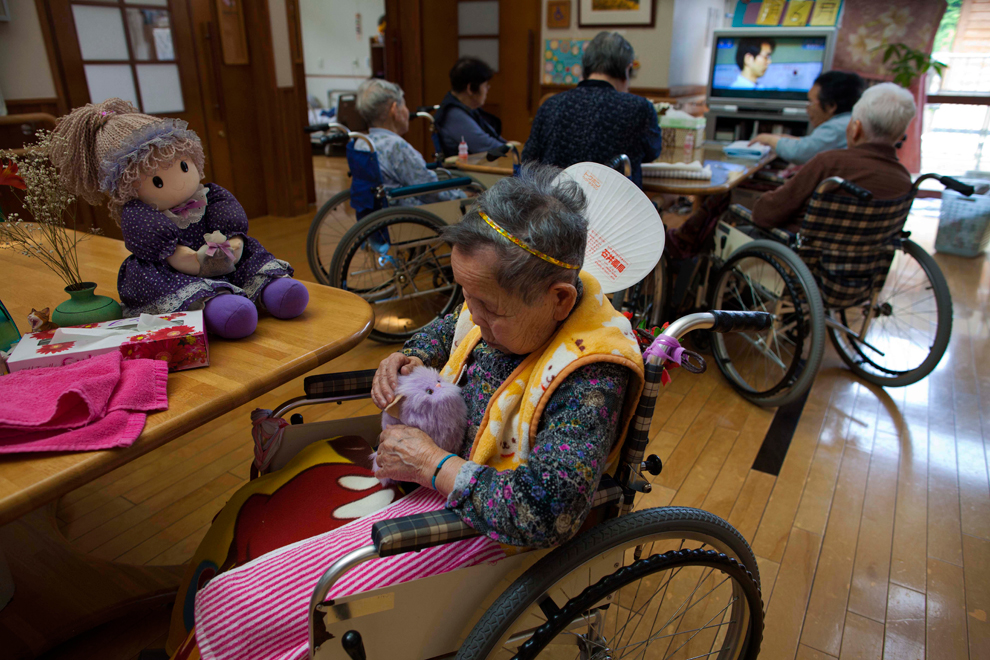
In this June 7, 2011 photo, residents of a nursing home in Itate, Japan rest in a community room. Itate is located northwest, and just outside of the official nuclear exclusion zone but registers some of the highest levels of radiation in the prefecture and was largely abandoned over the summer. Employees of the nursing home say that some residents of the nursing home elected to stay behind because they are old enough that they do not fear the long-term effects of exposure to radiation. Employees of the facility had mostly moved away but commute to work and rotate their shifts to limit their own exposure. (AP Photographer David Guttenfelder on assignment for National Geographic Magazine)
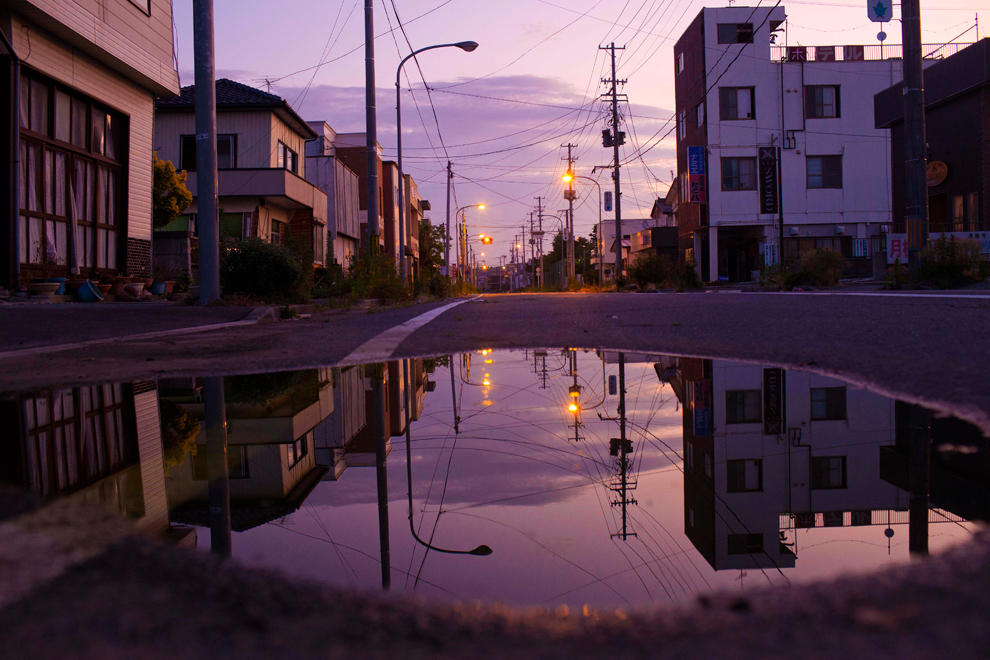
In this July 10, 2011 photo, the sun rises in the abandoned town of Namie, Japan, near the damaged Fukushima Daiichi nuclear power plant. (AP Photographer David Guttenfelder on assignment for National Geographic)
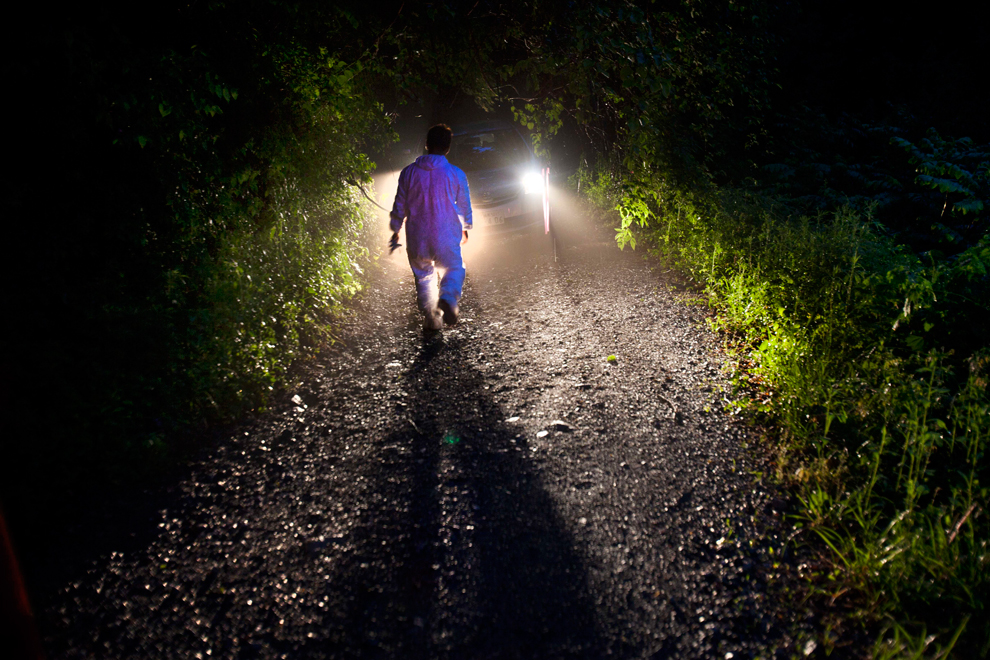
In this June 5, 2011 photo, an animal rights activist wearing a white suit to protect him from radiation, tries to guide a car through an overgrown mountain road near Naraha, Japan as he and his colleagues bypass police barricades to enter the nuclear exclusion zone so they can feed and rescue abandoned animals. (AP Photographer David Guttenfelder on assignment for National Geographic Magazine)
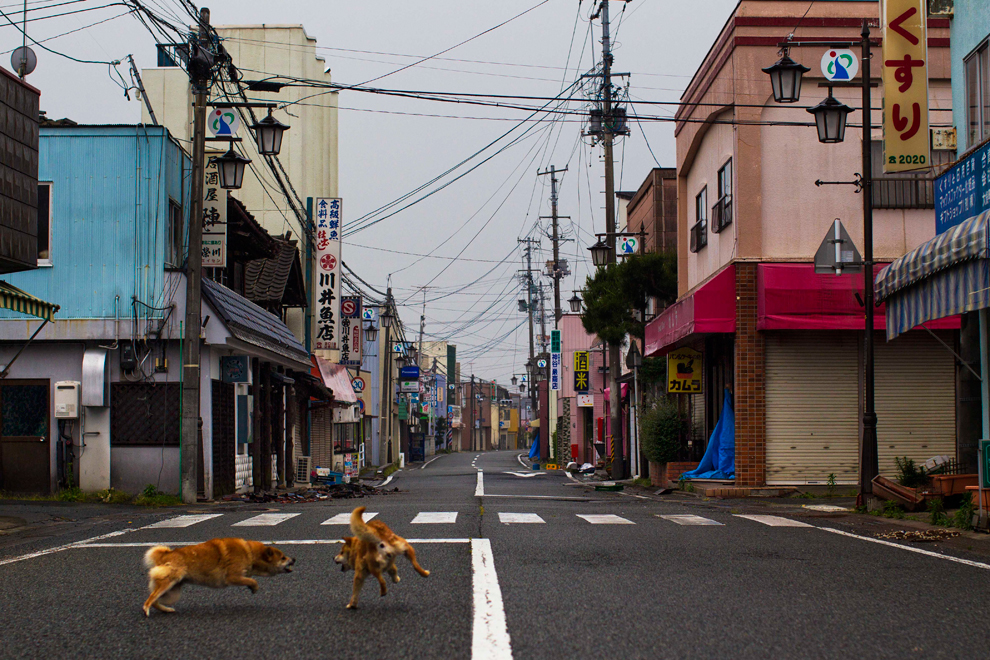
In this June 5, 2011 photo, two stray pet dogs fight in the deserted streets of Okuma, Japan. In the early days of the crisis, roaming farm animals and pets were everywhere inside the no-go zone. But by midsummer, some animals had been rescued and a number of others had perished of starvation and disease. (AP Photographer David Guttenfelder on assignment for National Geographic Magazine)
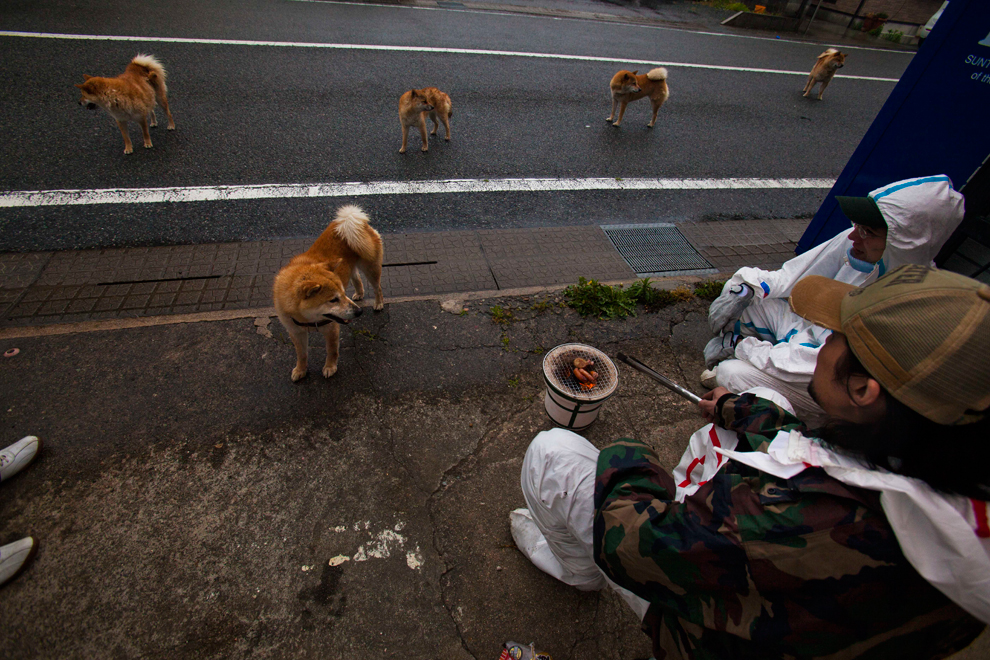
In this June 5, 2011 photo, Japanese animal rights activists Leo Hoshi (right) and Kei Asanuma grill meat to attract stray dogs as they try to rescue pets that evacuees from the nuclear exclusion zone left behind in the contaminated town of Okuma, Japan just three kilometers from the Fukushima Daiichi nuclear plant. (AP Photographer David Guttenfelder on assignment for National Geographic Magazine)
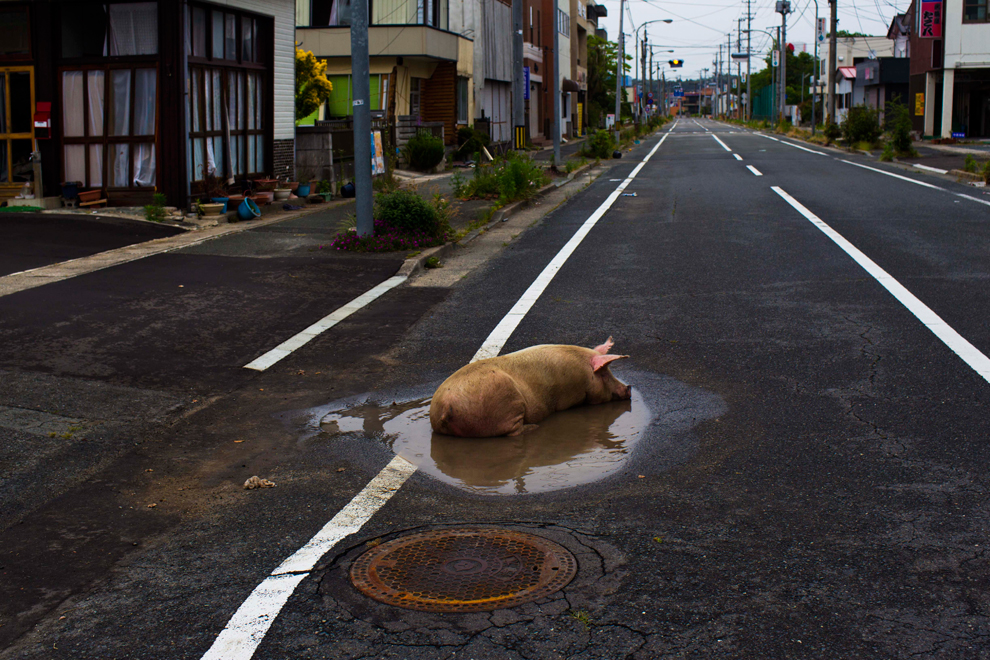
In this June 18, 2011 photo, a farmer's pig rests in a puddle on main street near the train station in central Namie, Japan less then six miles from the crippled nuclear reactor. Farmers across the area had to hastily leave their homes and were unable to evacuate livestock, or return to the irradiated zone to care for them. (AP Photographer David Guttenfelder on assignment for National Geographic Magazine)
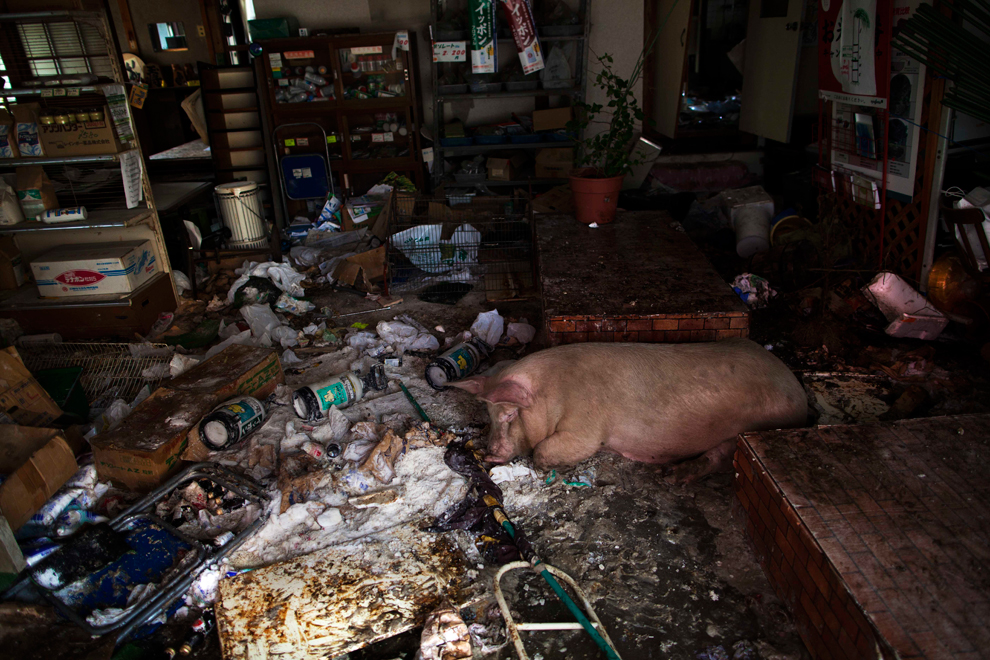
In this June 18, 2011 photo, a hog naps after eating a meal inside an abandoned feed store and wandering the deserted streets of radiation-contaminated Namie, Japan. (AP Photographer David Guttenfelder on assignment for National Geographic Magazine)

In this June 8, 2011 photo, Keigo Sakamoto holds two of his dogs in the front yard of his house. Sakamoto, a Japanese egg farmer, lives in Naraha on the 12-mile boundary line of the exclusion zone around the damaged nuclear power station. He is allowed to stay in his home but must bypass the police barricades and lost his livelihood when the neighbors and nearby towns were evacuated. (AP Photographer David Guttenfelder on assignment for National Geographic Magazine)
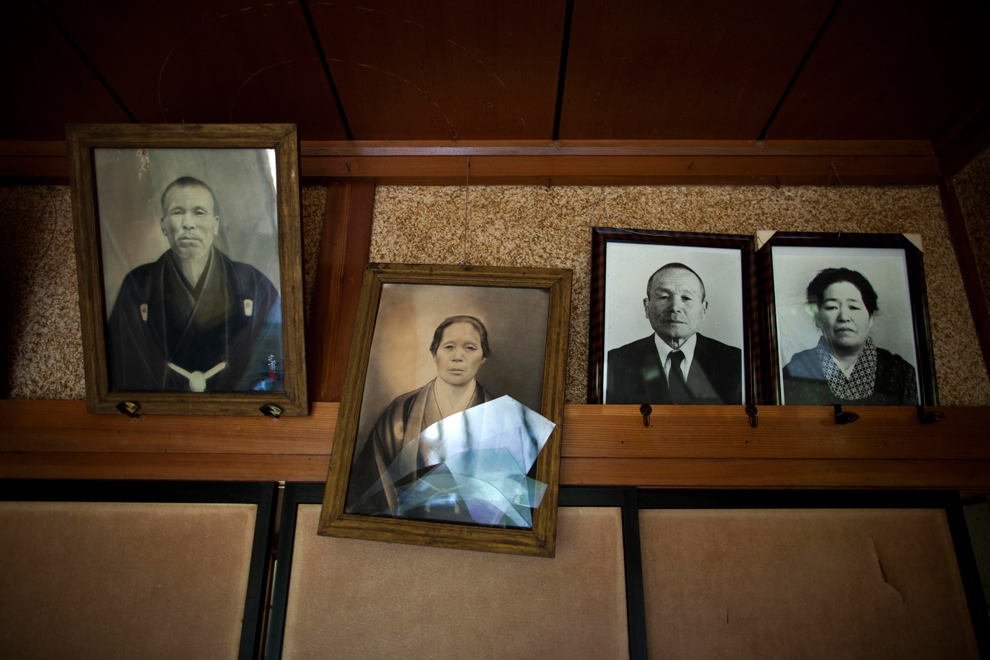
In this July 9, 2011 photo, a family member's portrait, dislodged and shattered by the March 11 earthquake, hangs on the wall of an abandoned farmhouse in Naraha, Japan within the exclusion zone. (AP Photographer David Guttenfelder on assignment for National Geographic)
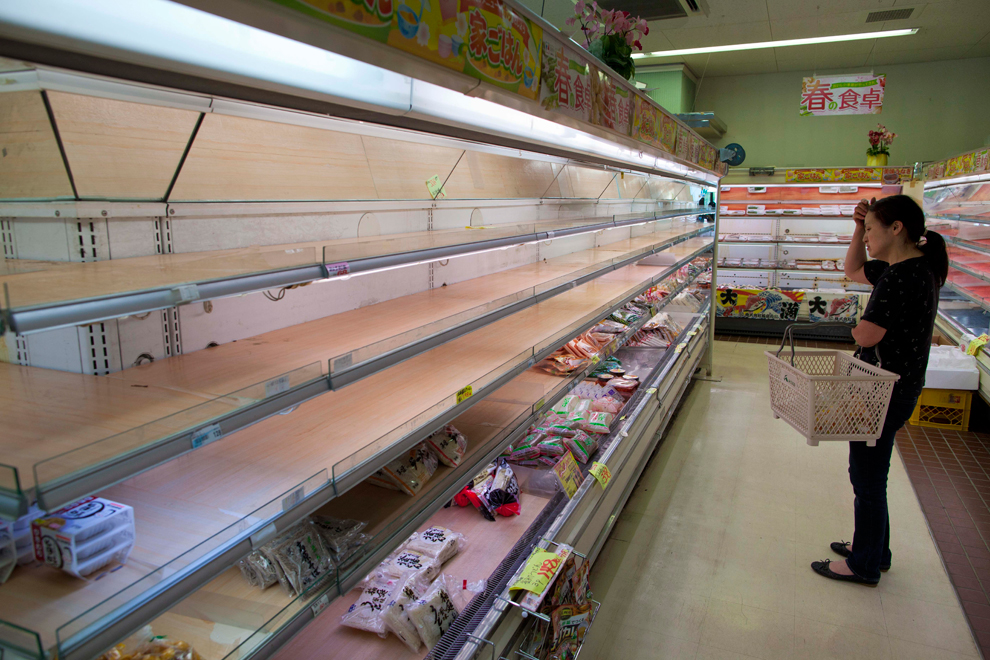
In this July 22, 2011 photo, a woman shops for groceries despite the shelves being mostly empty during the final days of a gradual process of evacuation of the town of Itate, Japan. Itate is northwest, and just outside of the official nuclear exclusion zone, but registers some of the highest levels of radiation in the prefecture and was largely abandoned over the summer. (AP Photographer David Guttenfelder on assignment for National Geographic Magazine)
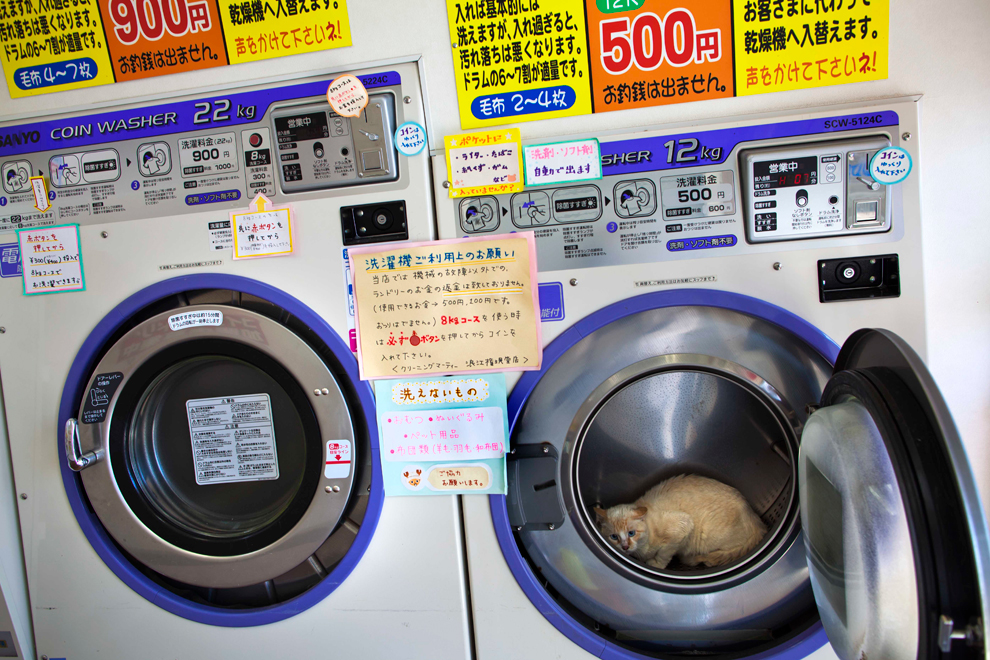
In this June 19, 2011 photo, a stray pet cat rests inside a dryer at an abandoned coin laundry in central Namie, Japan less than six miles from the crippled nuclear reactor. (AP Photographer David Guttenfelder on assignment for National Geographic Magazine)
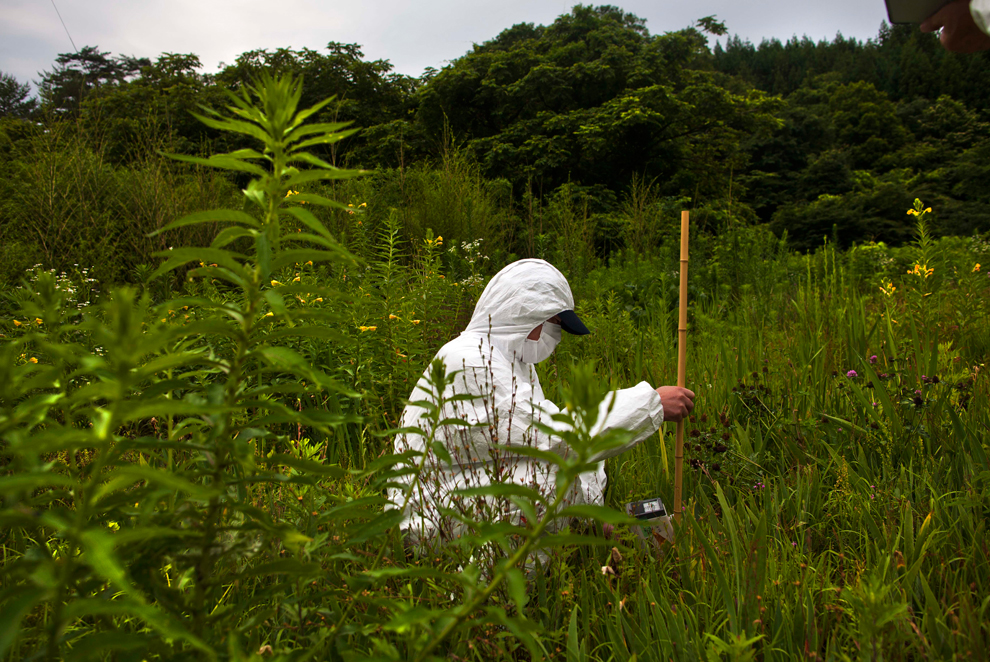
In this July 8, 2011 photo, a member of the Namie, Japan school board wears a protective suit while measuring radiation levels in a field in his community inside the nuclear exclusion zone. (AP Photographer David Guttenfelder on assignment for National Geographic Magazine)
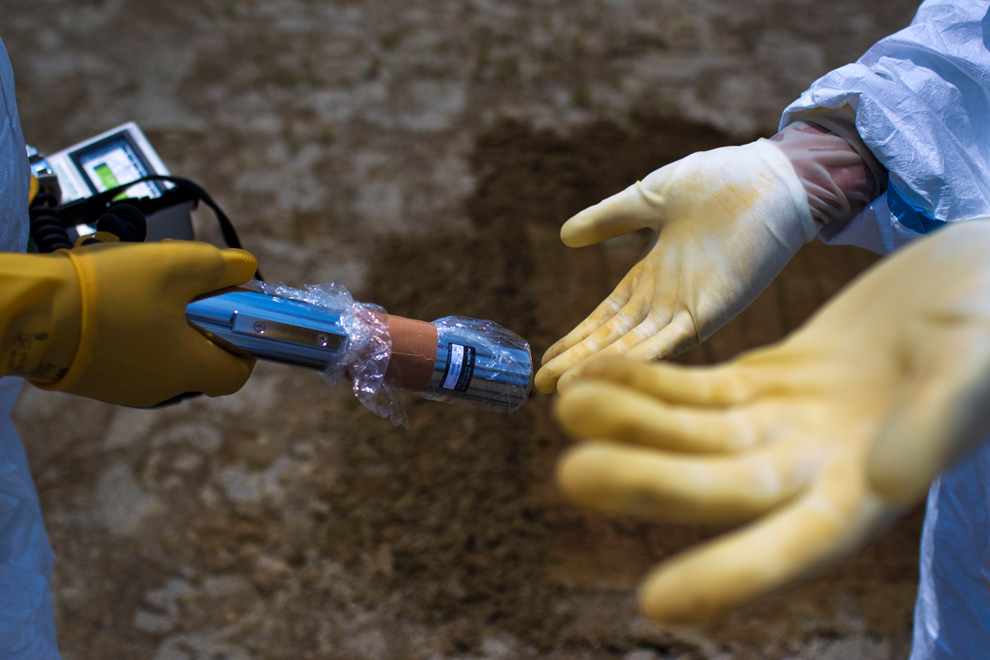
In this July 26, 2011 photo, a member of the Namie, Japan school board checks the hands of a colleague as they measure radiation levels in a baseball and soccer field in their community inside the nuclear exclusion zone. (AP Photographer David Guttenfelder on assignment for National Geographic Magazine)
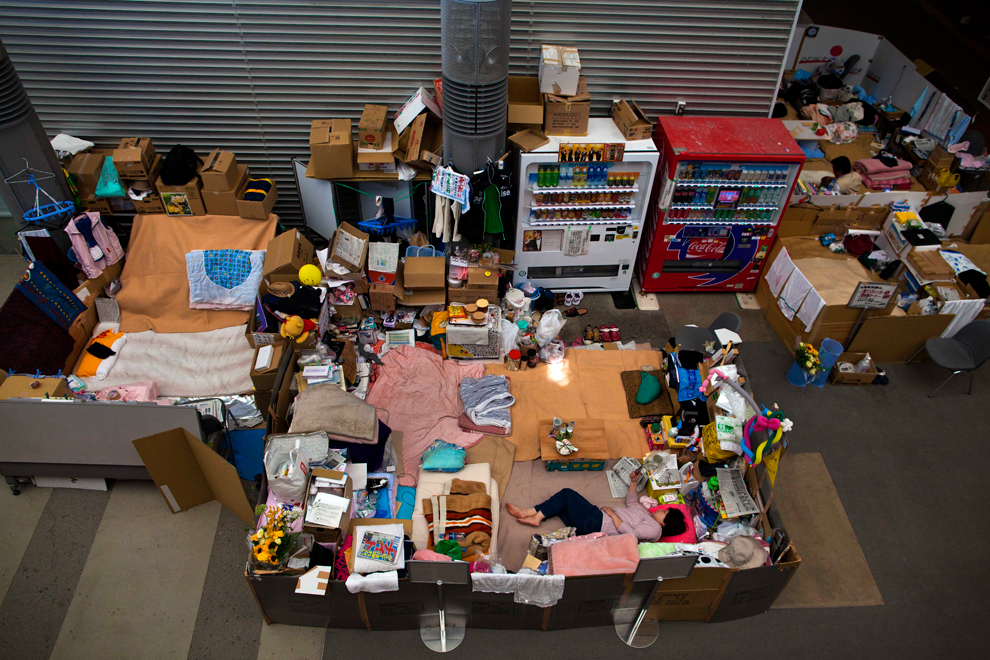
In this June 9, 2011 photo, an evacuee lies down in her makeshift temporary home on the floor of the Big Palette convention center in Koriyama, Japan. Tens of thousands of people fled their homes surrounding the damaged nuclear power plant. (AP Photographer David Guttenfelder on assignment for National Geographic Magazine)
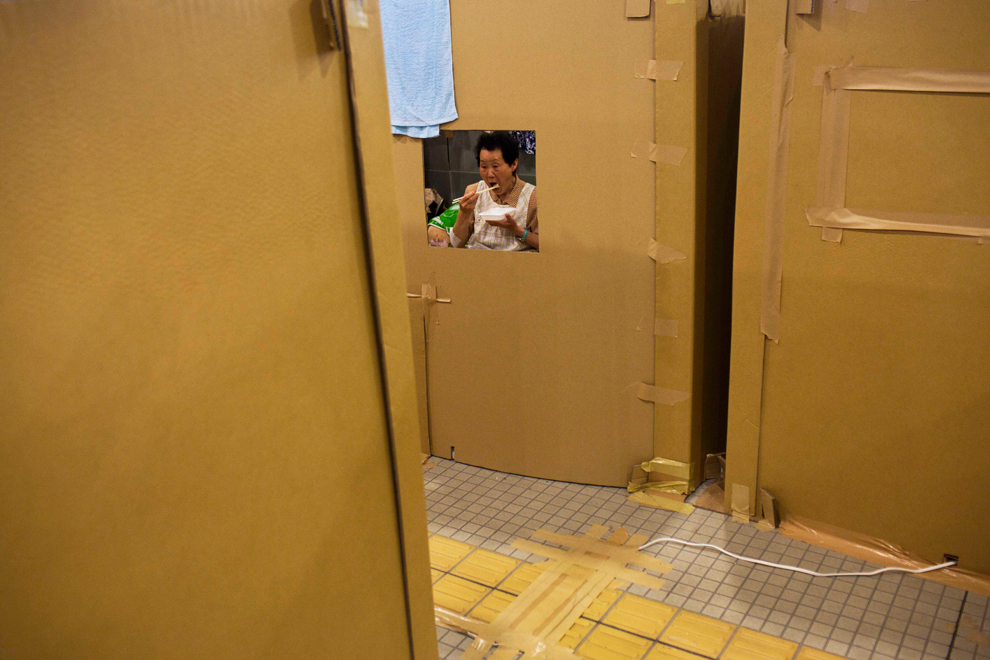
In this June 9, 2011 photo, evacuee Nobuko Sanpei, 74, eats rice in her cardboard-box home on a hallway floor in a convention center in Koriyama, Japan. Sanpei, who has since moved to a small apartment, farmed rice with her husband in Tomioka, Japan less than six miles from the power station. (AP Photographer David Guttenfelder on assignment for National Geographic Magazine)
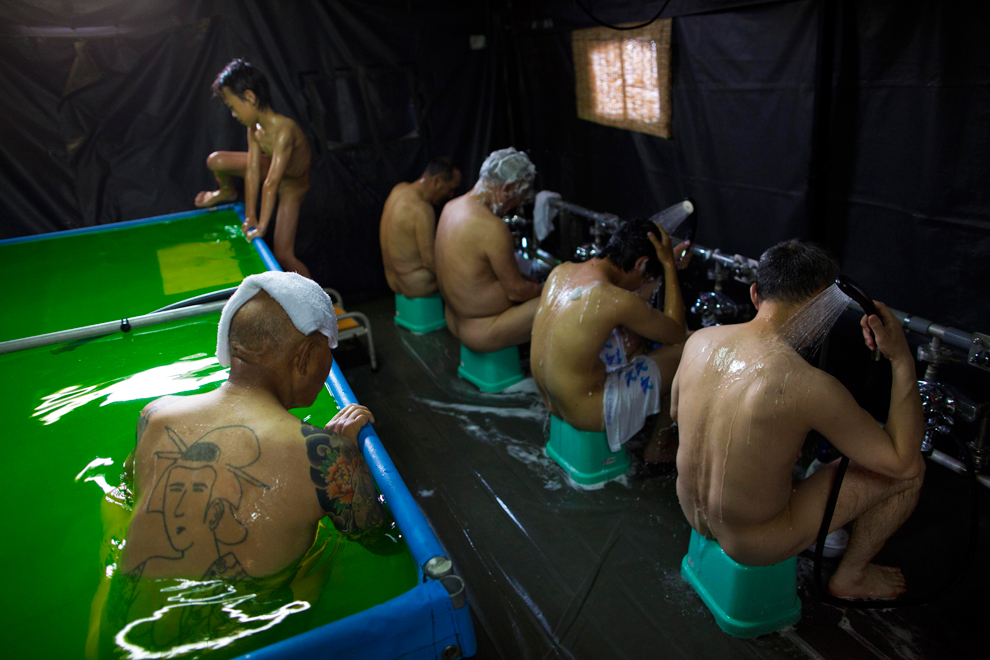
In this June 9, 2011 photo, 69-year-old and tattooed Toyoo Ide bathes with fellow evacuees in a traditional Japanese-style bath set up in a tent by Japan's Self-Defense Forces at an evacuation center in Koriyama, Japan. "There's no water or electricity now, but if there were, I'd go back, radioactivity or not. I'd go back today. I can't live in a stranger's town," said Ide who was a lifelong employee of the nuclear power plant. (AP Photographer David Guttenfelder on assignment for National Geographic Magazine)

In this June 26, 2011 photo, vines grow across the highway near the town of Tomioka, Japan inside the nuclear exclusion zone. (AP Photographer David Guttenfelder on assignment for National Geographic Magazine)
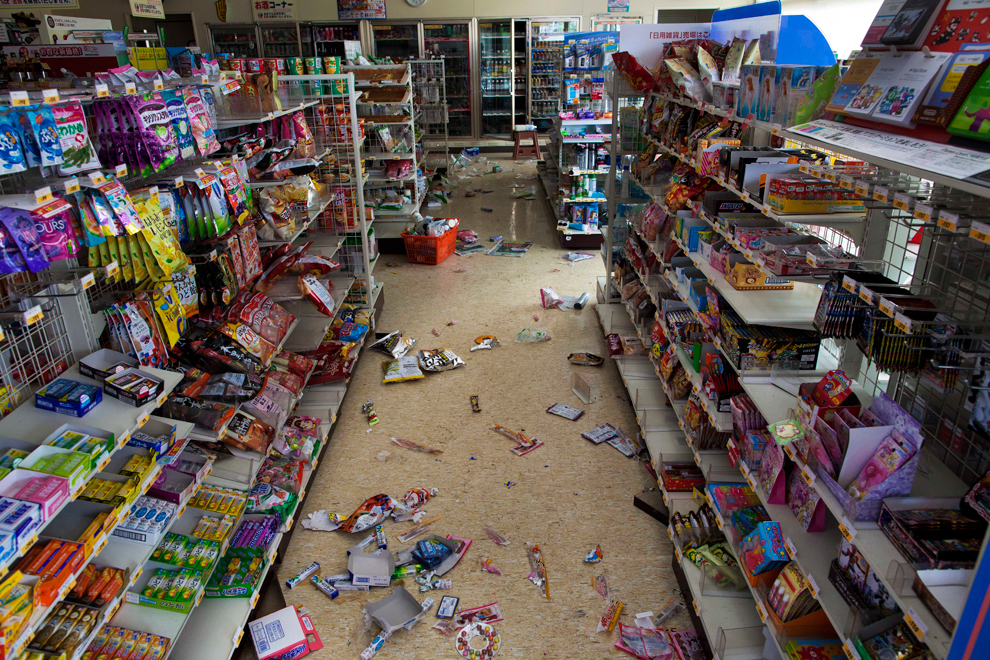
In this June 18, 2011 photo, packaged items lie on the floor of a convenience store in Futaba, Japan near the nuclear power plant. The items were left untouched since the earthquake shook the region on March 11. (AP Photographer David Guttenfelder on assignment for National Geographic Magazine)
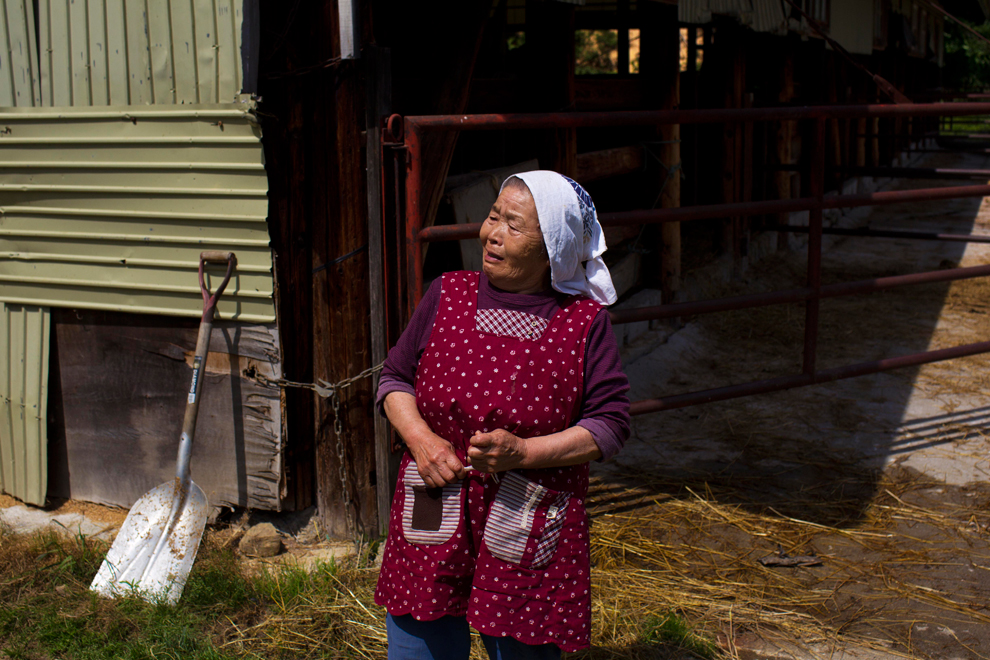
In this June 22, 2011 photo, Fuyono Kitayama, 83, cries after her last calf is loaded into a truck as she and her husband prepare to be evacuated from Itate, Japan. Itate is northwest, and just outside of the official nuclear exclusion zone but registers some of the highest levels of radiation in the prefecture and was largely abandoned over the summer. (AP Photographer David Guttenfelder on assignment for National Geographic Magazine)
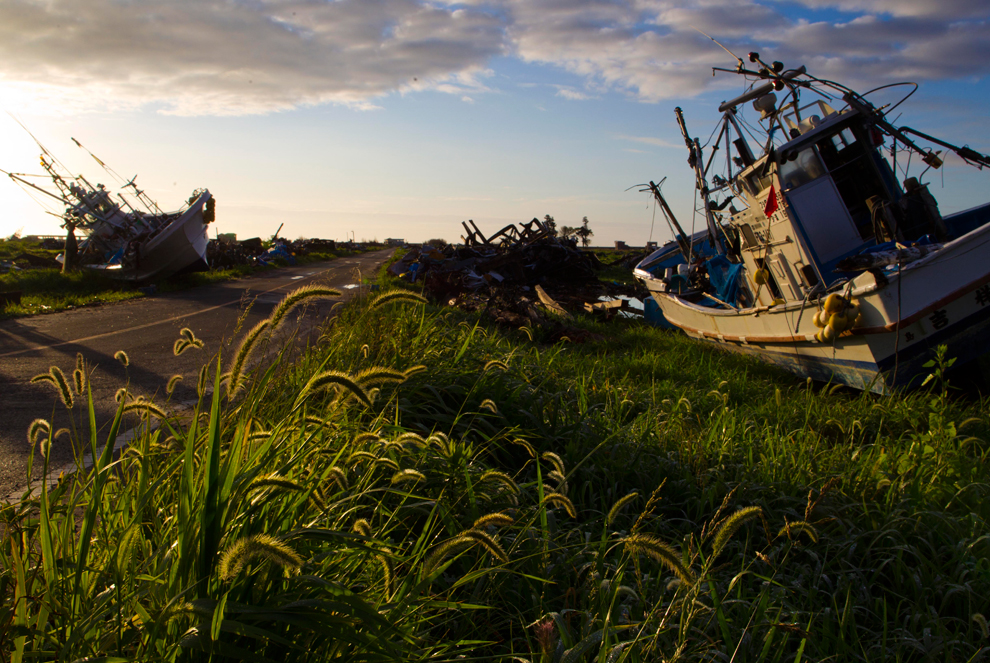
In this July 24, 2011 photo, ships that washed inland with the tsunami sit along a road inside the nuclear contaminated exclusion zone in Namie, Japan. (AP Photographer David Guttenfelder on assignment for National Geographic Magazine)
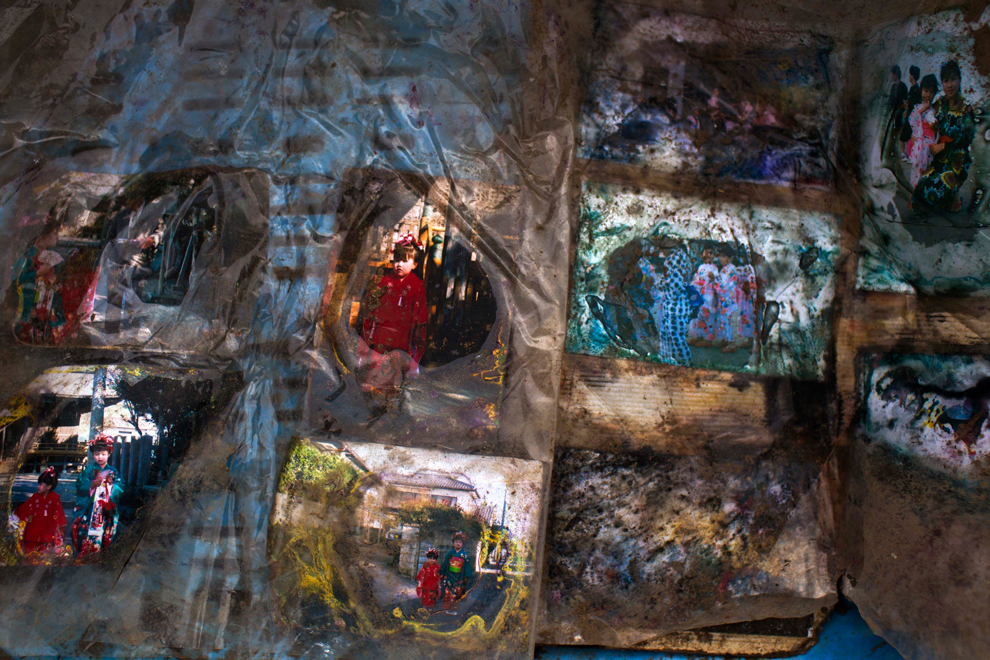
This July 8, 2011 photo shows a waterlogged family photo album left behind in the town of Namie, Japan on Fukushima's tsunami-ravaged coast. In the pictures the children are dressed in fine kimonos worn during a traditional celebration when children turn three, five, and seven. (AP Photographer David Guttenfelder on assignment for National Geographic Magazine)
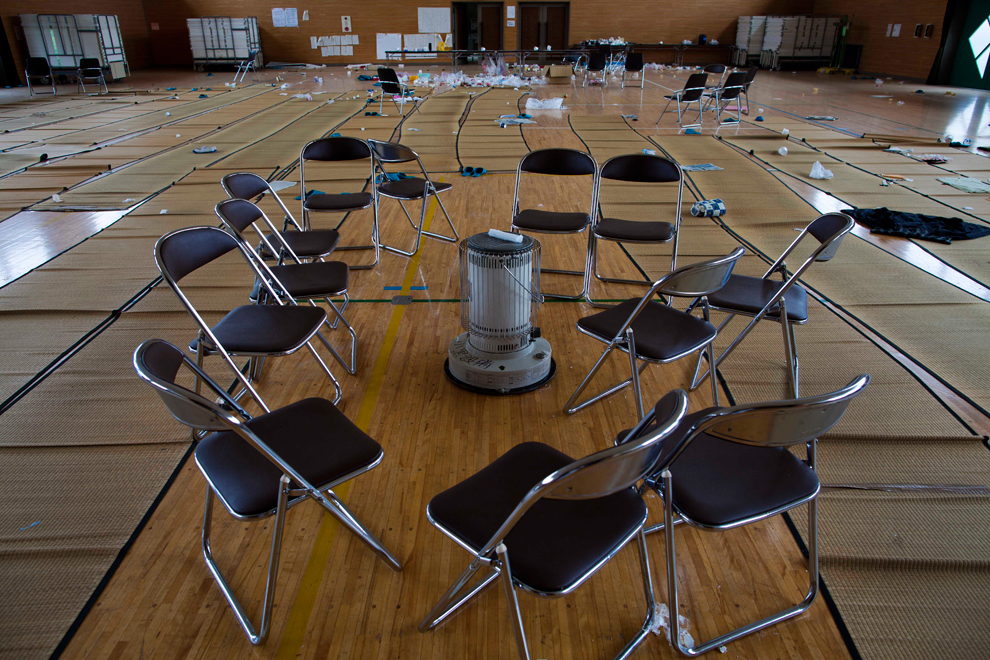
In this July 8, 2011 photo, empty chairs sit around a theater inside a building next to the mayor's office where residents of Namie, Japan spent the first night after the tsunami struck. Months after the earthquake, tsunami, and nuclear reactor disaster sent the town of Namie's residents fleeing, few have been allowed to return for brief visits. Public and private buildings have been left largely untouched since the disaster struck. (AP Photographer David Guttenfelder on assignment for National Geographic)
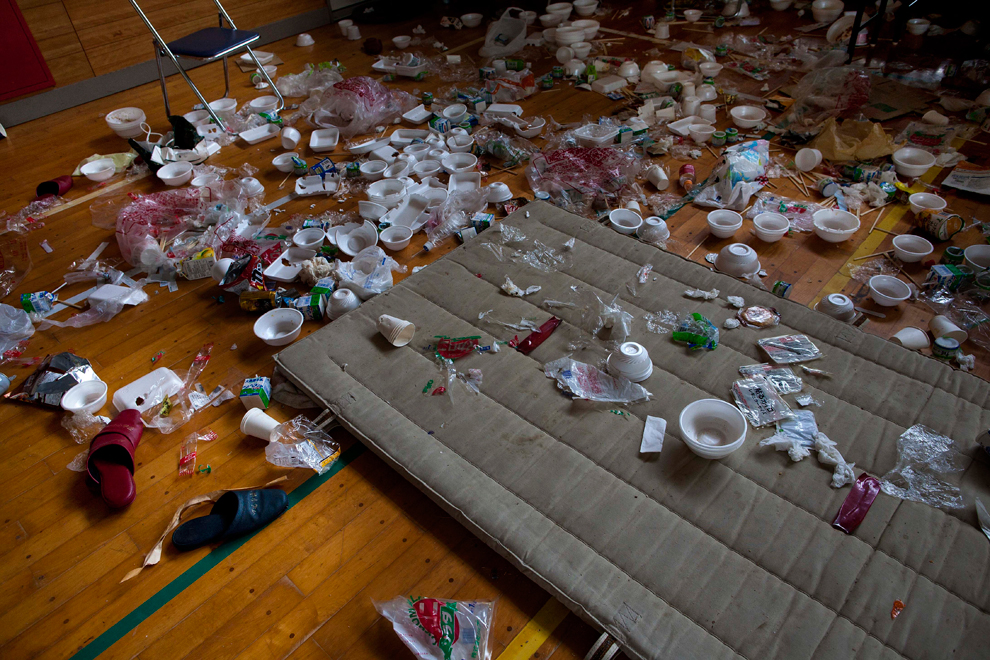
In this July 26, 2011 photo, meal debris and personal effects lie on the floor of the gymnasium at Karino Elementary School, which was used as an evacuation shelter shortly after the nuclear crisis erupted, in the town of Namie, Japan. (AP Photographer David Guttenfelder on assignment for National Geographic Magazine)

This July 8, 2011 photo shows the damaged gymnasium floor which sank after tsunami waves swept across the neighborhood at a school near the coast in Namie, Japan. The signs on the school stage were placed before the March 11 quake and tsunami in preparation for a graduation ceremony. (AP Photographer David Guttenfelder on assignment for National Geographic Magazine)

In this July 10, 2011 photo, a water mark cuts across the backs of theater seats at a planetarium in Namie, Japan after tsunami waves swept across parts of the town. (AP Photographer David Guttenfelder on assignment for National Geographic)
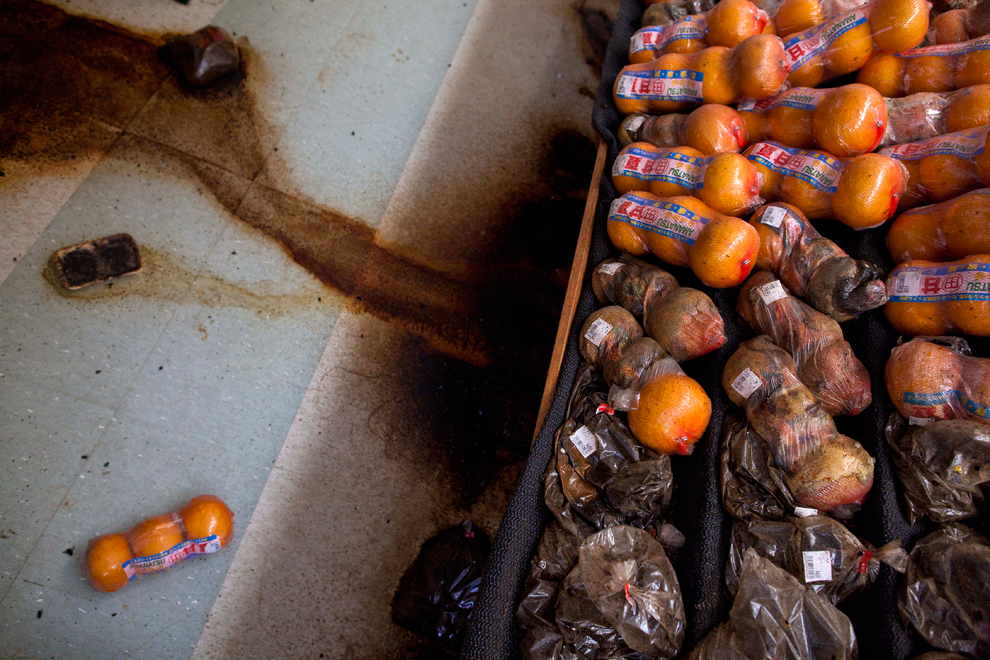
In this July 26, 2011 photo, oranges, which were left behind when the town of Namie, Japan was evacuated, rot on the shelves and floor of the town's main supermarket. (AP Photographer David Guttenfelder on assignment for National Geographic)

In this June 18, 2011 photo, a mud-caked television remote control device sits on a table above a mud-covered and cracked floor of an abandoned home in Odaka, Japan in the wake of the March 11 earthquake and tsunami. (AP Photographer David Guttenfelder on assignment for National Geographic Magazine)
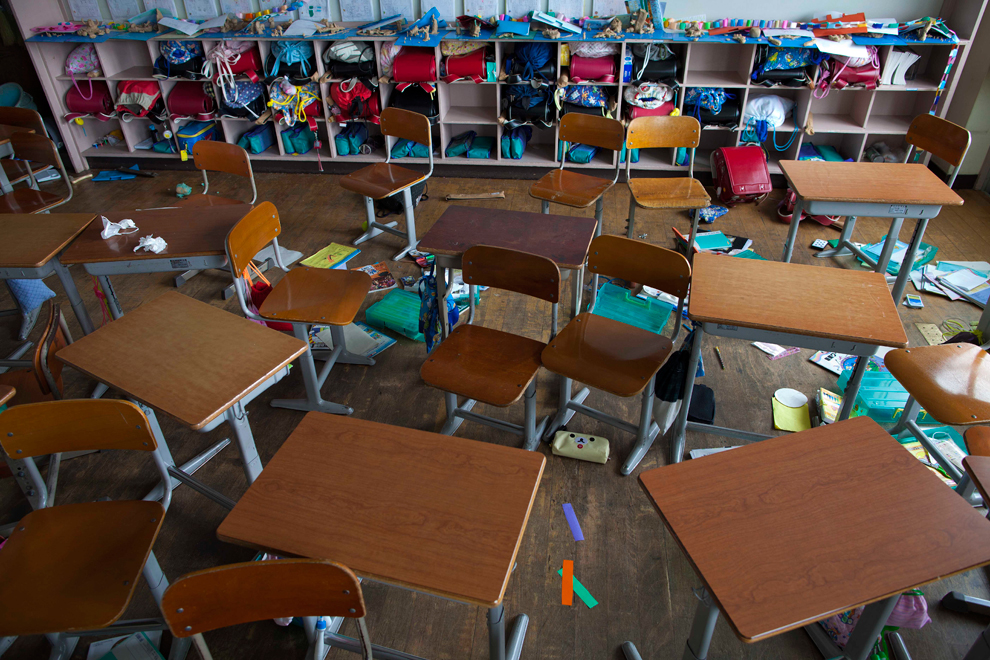
In this June 19, 2011 photo, children's desks, backpacks, and school supplies lie abandoned inside an earthquake-rattled primary school classroom in Namie, Japan. Months have gone by since the students fled following the March 11, 2011 earthquake and tsunami, and it is uncertain when or if the children will be able to return or reclaim their possessions. (AP Photographer David Guttenfelder on assignment for National Geographic Magazine)
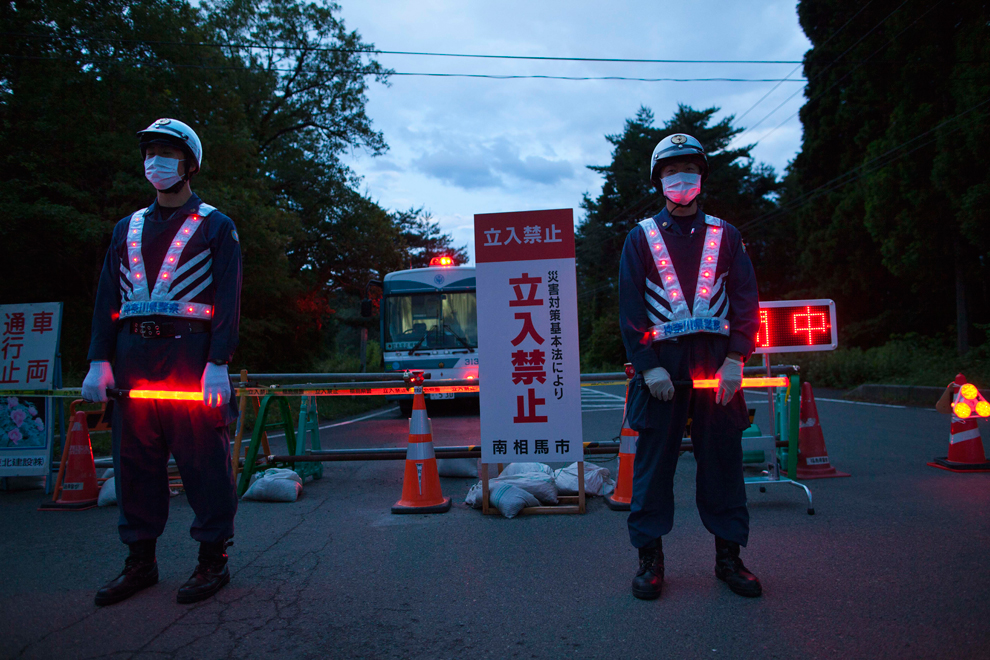
In this June 21, 2011 photo, police with glowing wands and vests and wearing protective face masks guard a road leading into the nuclear exclusion zone near the city of Minami-Soma, Japan. The sign behind them reads "Keep Out" in Japanese. (AP Photographer David Guttenfelder on assignment for National Geographic Magazine)
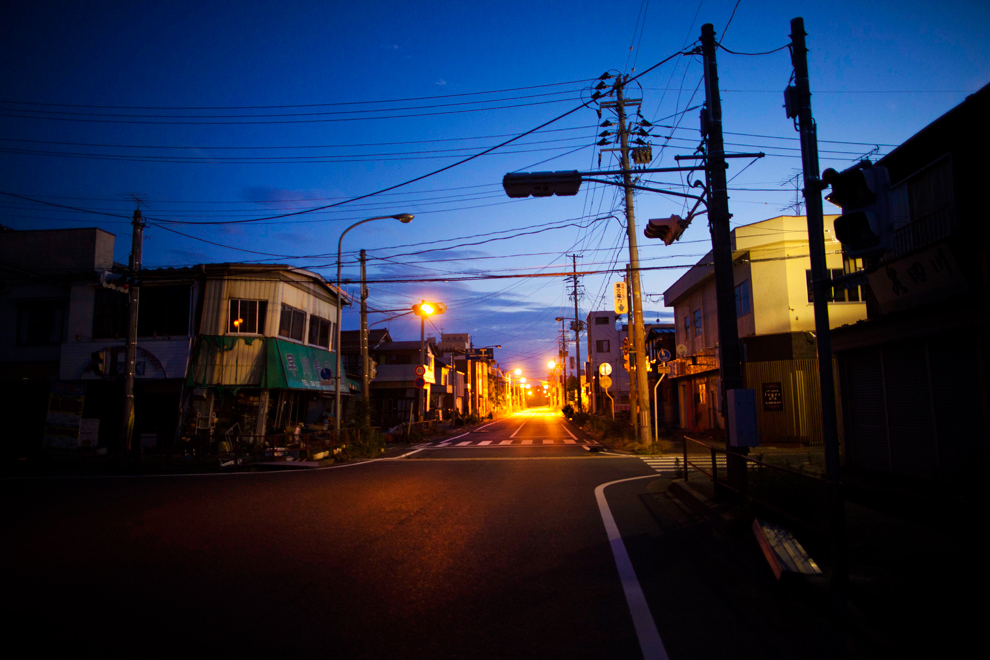

No comments:
Post a Comment